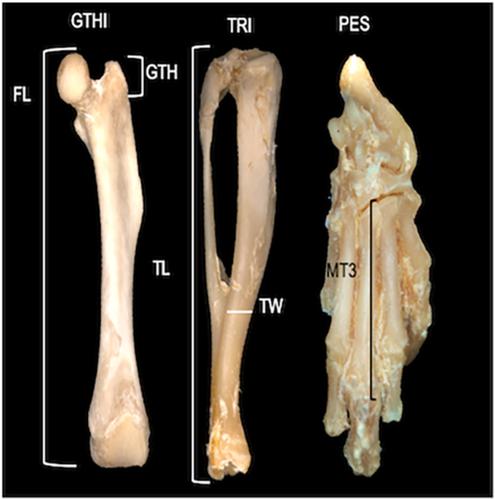当前位置:
X-MOL 学术
›
J. Morphol.
›
论文详情
Our official English website, www.x-mol.net, welcomes your feedback! (Note: you will need to create a separate account there.)
Hind foot drumming: Morphofunctional analysis of the hind limb osteology in three species of African mole‐rats (Bathyergidae)
Journal of Morphology ( IF 1.5 ) Pub Date : 2020-02-07 , DOI: 10.1002/jmor.21110 Lauren Sahd 1 , Nigel C Bennett 2 , Sanet H Kotzé 1
Journal of Morphology ( IF 1.5 ) Pub Date : 2020-02-07 , DOI: 10.1002/jmor.21110 Lauren Sahd 1 , Nigel C Bennett 2 , Sanet H Kotzé 1
Affiliation

|
Hind foot drumming is a form of seismic signaling that plays a vital role in the communication of several Bathyergidae species. Hind foot drumming is initiated by the rapid movement of the whole hind limb by flexion and extension of the hip and knee. This study aimed to determine if morphological adaptations of the hind limb osteology were measurable using established morphometric analyses in two drumming (Bathyergus suillus and Georychus capensis) and one non‐drumming (Cryptomys hottentotus natalensis) African mole‐rat species. Forty‐three linear measurements of the hind limb were taken in 48 limbs (n = 16 limbs per species) and 32 indices were calculated. Mixed model analysis of variance was used to compare the three species and sexes within a species. Thirteen indices had significant differences between species. Eleven indices had significant differences between sexes within a species. Significant differences between the drumming (B. suillus and G. capensis) and the non‐drumming species were observed in three indices. The femoral greater trochanter was relatively shorter in the drumming species compared to the non‐drumming species, which is proposed to allow for increased hip joint mobility, thereby permitting drummers to move their limbs at the rapid speed required to generate seismic signals. Furthermore, the small in‐lever (shorter greater trochanter) may increase the velocity of limb motion. The robust tibias in the drumming species, as indicated by the tibial robustness index, are likely to counter the additional biomechanical load caused by the muscles involved in hind foot drumming. The relatively small hind feet seen in the drumming species allows for reduced limb weight needed for the rapid extension and flexion motion required during hind foot drumming. The significant differences reflected in the hind limb osteological indices between B. suillus and G. capensis and the non‐drumming species are indicative of adaptations for hind foot drumming.
中文翻译:

后足击鼓:三种非洲鼹鼠(Bathyergidae)后肢骨学的形态功能分析
后足击鼓是一种地震信号形式,在几种 Bathyergidae 物种的交流中起着至关重要的作用。后足击鼓是由整个后肢通过髋关节和膝关节的屈曲和伸展的快速运动而开始的。本研究旨在确定后肢骨学的形态学适应性是否可以使用两种鼓类(Bathyergus suillus 和 Georychus capensis)和一种非鼓类(Cryptomys hottentotus natalensis)非洲鼹鼠物种的既定形态测量分析进行测量。在 48 个肢体(每个物种 n = 16 个肢体)中对后肢进行了 43 次线性测量,并计算了 32 个指数。方差的混合模型分析用于比较三个物种和物种内的性别。13 个指标在物种间存在显着差异。11 个指标在一个物种内的性别之间存在显着差异。在三个指数中观察到鼓形(B. suillus 和 G. capensis)与非鼓形物种之间的显着差异。与非鼓类动物相比,鼓类动物的股骨大转子相对较短,这被认为是为了增加髋关节的活动性,从而允许鼓手以产生地震信号所需的快速速度移动他们的四肢。此外,小内杆(较短的大转子)可能会增加肢体运动的速度。如胫骨坚固指数所示,击鼓物种中的强壮胫骨可能会抵消后足击鼓所涉及的肌肉引起的额外生物力学负荷。在击鼓物种中看到的相对较小的后足允许减轻在后足击鼓过程中所需的快速伸展和弯曲运动所需的肢体重量。B. suillus 和 G. capensis 与非击鼓物种之间的后肢骨学指数反映的显着差异表明对后足击鼓的适应性。
更新日期:2020-02-07
中文翻译:

后足击鼓:三种非洲鼹鼠(Bathyergidae)后肢骨学的形态功能分析
后足击鼓是一种地震信号形式,在几种 Bathyergidae 物种的交流中起着至关重要的作用。后足击鼓是由整个后肢通过髋关节和膝关节的屈曲和伸展的快速运动而开始的。本研究旨在确定后肢骨学的形态学适应性是否可以使用两种鼓类(Bathyergus suillus 和 Georychus capensis)和一种非鼓类(Cryptomys hottentotus natalensis)非洲鼹鼠物种的既定形态测量分析进行测量。在 48 个肢体(每个物种 n = 16 个肢体)中对后肢进行了 43 次线性测量,并计算了 32 个指数。方差的混合模型分析用于比较三个物种和物种内的性别。13 个指标在物种间存在显着差异。11 个指标在一个物种内的性别之间存在显着差异。在三个指数中观察到鼓形(B. suillus 和 G. capensis)与非鼓形物种之间的显着差异。与非鼓类动物相比,鼓类动物的股骨大转子相对较短,这被认为是为了增加髋关节的活动性,从而允许鼓手以产生地震信号所需的快速速度移动他们的四肢。此外,小内杆(较短的大转子)可能会增加肢体运动的速度。如胫骨坚固指数所示,击鼓物种中的强壮胫骨可能会抵消后足击鼓所涉及的肌肉引起的额外生物力学负荷。在击鼓物种中看到的相对较小的后足允许减轻在后足击鼓过程中所需的快速伸展和弯曲运动所需的肢体重量。B. suillus 和 G. capensis 与非击鼓物种之间的后肢骨学指数反映的显着差异表明对后足击鼓的适应性。


























 京公网安备 11010802027423号
京公网安备 11010802027423号